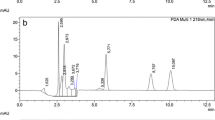Abstract
Deoxynivalenol (DON) is one of most widespread mycotoxins in cereal commodities, and animal feed is prevalently contaminated at high concentrations. This poses a problem in animal nutrition as especially pigs are very sensitive to DON. An effective process for the reduction of the DON concentration is the treatment of contaminated feed with sodium bisulfite (SBS) whereby DON is transformed into DON-sulfonate (DONS). Although the success of this treatment has been confirmed in several feeding studies, it is unexplained if the decrease of DON is accompanied with a coincident increase of DONS. For this reason, we developed a method for the analysis of DONS using hydrophilic interaction chromatography coupled to tandem mass spectrometry. In order to investigate the correlation between DON and DONS concentrations during SBS-treatment, DON-contaminated wheat was treated with SBS and stored for up to 36 days. At defined timepoints of this treatment, samples were analyzed for DON and DONS using stable isotope labeled standards. The preparation, purification, and structure elucidation of DONS, and the HILIC-HPLC-MS/MS method for the analysis of DONS as well as the results of two storage experiments are presented in this paper.







Similar content being viewed by others
References
Alpert AJ (1990) Hydrophilic-interaction chromatography for the separation of peptides, nucleic acids and other polar compounds. J Chromatogr 499:177–196
Altpeter F, Posselt UK (1994) Production of high quantities of 3-acetyldeoxynivalenol and deoxynivalenol. Appl Microbiol Biotechnol 41:384–387
Bretz M, Beyer M, Cramer B, Humpf HU (2006) Stable isotope dilution analysis of the Fusarium mycotoxins deoxynivalenol and 3-acetyldeoxynivalenol. Mol Nutr Food Res 50:251–260
Dänicke S, Valenta H, Gareis M, Lucht HW, von Reichenbach H (2005) On the effects of a hydrothermal treatment of deoxynivalenol (DON)-contaminated wheat in the presence of sodium metabisulphite (Na2S2O5) on DON reduction and on piglet performance. Anim Feed Sci Technol 118:93–108
Dänicke S, Beineke A, Goyarts T, Valenta H, Beyer M, Humpf HU (2008a) Effects of a Fusarium toxin-contaminated triticale, either untreated or treated with sodium metabisulphite (Na2S2O5, SBS), on weaned piglets with a special focus on liver function as determined by the 13C-methacetin breath test. Arch Anim Nutr 62:263–286
Dänicke S, Döll S, Goyarts T, Valenta H, Ueberschär KH, Flachowsky G (2008b) On the evaluation of the occurrence of the Fusarium-toxins deoxynivalenol (DON), zearalenone (ZON) and their metabolites in physiological substrates of the pig. Tierärztl Prax 36:35–47
Dänicke S, Beyer M, Breves G, Valenta H, Humpf H-U (2010) On the effects of oral exposure of pigs to deoxynivalenol (DON) sulfonate (DONS) as the non-toxic derivative of DON on tissue residues of DON and de-epoxy-DON and on DONS blood levels. Food Add Cont (submitted)
Eriksen GS, Alexander J (1998) Fusarium toxins in cereals - a risk assessment. Nordic Council of Ministers, Tema Nord
EFSA (2004) Opinion of the Scientific Panel on Contaminants in the Food Chain on a request from the Commission related to Deoxynivalenol (DON) as undesirable substance in animal feed. The EFSA Journal 73:1-41 (available at: http://www.efsa.eu.int/)
Forsell JH, Jensen R, Tai J-H, Witt M, Lin WS, Pestka JJ (1987) Comparison of acute toxicities of deoxynivalenol (vomitoxin) and 15-acetyldeoxynivalenol in the B6C3F1 mouse. Food Chem Toxicol 25:155–162
Klötzel M, Lauber U, Humpf HU (2006) A new solid phase extraction clean-up method for the determination of 12 type A and B trichothecenes in cereals and cereal-based food by LC-MS/MS. Mol Nutr Food Res 50:261–269
Leonhardt BA, DeVilbiss ED (1985) Separation and double-bond determination on nanogram quantities of aliphatic monounsaturated alcohols, aldehydes and carboxylic acid methyl esters. J Chromatogr 322:484–490
Maume B, Wilson WE, Horning EC (1968) Gas chromatographic and mass spectrometric study of trimethylsilyl ethers of cardic aglycones. Anal Letters 1:401–415
Rotter BA, Prelusky DB, Pestka JJ (1996) Toxicology of deoxynivalenol (vomitoxin). J Toxicol Environ Health 48:1–34
SCF (1999) Scientific Committee on Food, Opinion on Fusarium toxins, Part 1: Deoxynivalenol (DON) (http://ec.europa.eu/food/fs/sc/scf/out44_en.pdf, letzter Zugriff: 28.02.2009)
SCF (2002) Scientific committee on food, opinion of the scientific committee on food on fusarium toxins, part 6: Group evaluation of T-2 toxin, HT-2 toxin, nivalenol and deoxynivalenol, 2002 (http://europa.eu.int/comm/food/fs/sc/scf/out123_en.pdf, letzter Zugriff: 28.02.2009)
Shepard MJ, Gilbert J (1988) Long-term storage stability of deoxynivalenol standard reference solutions. J Agric Food Chem 36:305–308
Sydenham EW, Thiel PG (1996) Physicochemical data for some selected Fusarium toxins. J AOAC Int 79:1365–1379
Widestrand J, Pettersson H (2001) Effect of time, temperature and solvent on the stability of T-2 toxin, HT-2 toxin, deoxynivalenol and nivalenol calibrants. Food Addit Contam 18:987–992
Yoshizawa T, Morooka N (1974) Studies on the toxic substances in infected cereals: acute toxicities of new trichothecene mycotoxins deoxynivalenol and its monoacetate. J Food Hyg Soc Jpn 15:261–269
Young JC (1986) Formation of sodium bisulfite addition products with trichothecenones and alkaline hydrolysis of deoxynivalenol and its sulfonate. J Agric Food Chem 34:919–923
Young JC, Subryan LM, Potts D, McLaren ME, Gobran FH (1986) Reduction in levels of deoxynivalenol in contaminated wheat by chemical and physical treatment. J Agric Food Chem 34:461–465
Young JC, Trenholm HL, Friend DW, Prelusky DB (1987) Detoxification of deoxynivalenol with sodium bisulfite and evaluation of the effects when pure mycotoxin or contaminated corn was treated and given to pigs. J Agric Food Chem 35:259–261
Acknowledgement
Financial support for this work was provided by the state of North-Rhine Westphalia and the European Union in the Ziel 2-Programm NRW.
Author information
Authors and Affiliations
Corresponding author
Rights and permissions
About this article
Cite this article
Beyer, M., Dänicke, S., Rohweder, D. et al. Determination of deoxynivalenol-sulfonate (DONS) in cereals by hydrophilic interaction chromatography coupled to tandem mass spectrometry. Mycotox Res 26, 109–117 (2010). https://doi.org/10.1007/s12550-010-0046-7
Received:
Revised:
Accepted:
Published:
Issue Date:
DOI: https://doi.org/10.1007/s12550-010-0046-7




